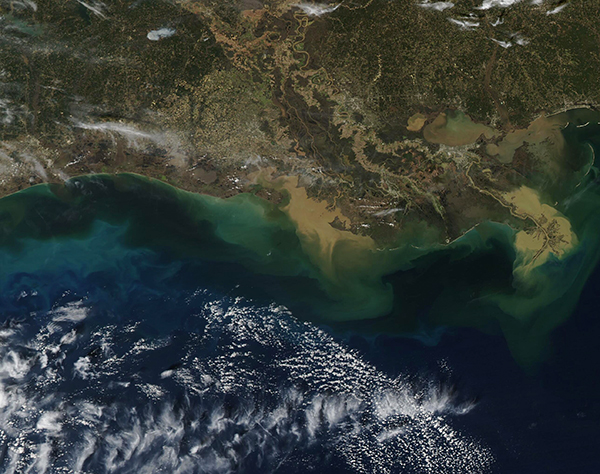Images
February 15, 2023 - Sediment and Phytoplankton in the Gulf of Mexico
Tweet
In January and early February 2023, a series of storms brought torrential rain and threats of tornadoes across Louisiana. When the skies cleared on February 13, the Moderate Resolution Imaging Spectroradiometer (MODIS) on board NASA’s Aqua satellite captured a true-color image of patches of tan and swirls of jewel-toned water in the Gulf of Mexico.
The largest patches of muddy-tan are caused by sediment pouring into the Gulf from the Mississippi River (east) and the Atchafalaya River (near the image center), no doubt runoff caused by the recent storms. Sediment appears tan when it floats near the surface, but as it sinks it looks green and then blue. This color shift is obvious near the large sediment plumes. Darker tan sediment can also be seen floating Lakes Maurepas, Pontchartrain, and Borgne which sit north of the Mississippi Delta.
Swirls of bright color can be seen in the dark Gulf waters west of the Atchafalaya plume and dull jewel-tones tint the water under broken layers of cloud in the south. While sediment may lend a little color here, phytoplankton are almost certainly playing a leading role in the jewel-toned appearance. Phytoplankton are microscopic plant-like organisms (algae) that live in these waters year-round in relatively small numbers. With adequate sunlight, nutrients, and warm water temperature, phytoplankton can reproduce explosively to create large and colorful blooms. Sediment-laden runoff carries an infusion of nutrients into the Gulf of Mexico, encouraging phytoplankton growth.
Image Facts
Satellite:
Aqua
Date Acquired: 2/13/2023
Resolutions:
1km (332.1 KB), 500m (891.2 KB), 250m (1.7 MB)
Bands Used: 1,4,3
Image Credit:
MODIS Land Rapid Response Team, NASA GSFC
Tweet
In January and early February 2023, a series of storms brought torrential rain and threats of tornadoes across Louisiana. When the skies cleared on February 13, the Moderate Resolution Imaging Spectroradiometer (MODIS) on board NASA’s Aqua satellite captured a true-color image of patches of tan and swirls of jewel-toned water in the Gulf of Mexico.
The largest patches of muddy-tan are caused by sediment pouring into the Gulf from the Mississippi River (east) and the Atchafalaya River (near the image center), no doubt runoff caused by the recent storms. Sediment appears tan when it floats near the surface, but as it sinks it looks green and then blue. This color shift is obvious near the large sediment plumes. Darker tan sediment can also be seen floating Lakes Maurepas, Pontchartrain, and Borgne which sit north of the Mississippi Delta.
Swirls of bright color can be seen in the dark Gulf waters west of the Atchafalaya plume and dull jewel-tones tint the water under broken layers of cloud in the south. While sediment may lend a little color here, phytoplankton are almost certainly playing a leading role in the jewel-toned appearance. Phytoplankton are microscopic plant-like organisms (algae) that live in these waters year-round in relatively small numbers. With adequate sunlight, nutrients, and warm water temperature, phytoplankton can reproduce explosively to create large and colorful blooms. Sediment-laden runoff carries an infusion of nutrients into the Gulf of Mexico, encouraging phytoplankton growth.
Image Facts
Satellite:
Aqua
Date Acquired: 2/13/2023
Resolutions:
1km (332.1 KB), 500m (891.2 KB), 250m (1.7 MB)
Bands Used: 1,4,3
Image Credit:
MODIS Land Rapid Response Team, NASA GSFC




